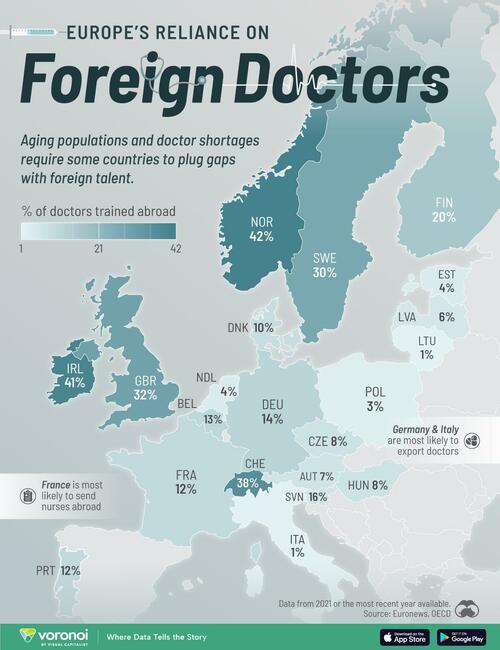Mapping Europe’s Reliance On Foreign Doctors
With an aging global population, age-related healthcare industries are expanding rapidly, leading to a shortage of nearly four million medical professionals, according to recent WHO estimates.
As a result, countries are vying to attract doctors trained in foreign countries, hoping to bolster their physician workforces.
This graphic, via Visual Capitalist’s Pallavi Rao, visualizes the share of foreign-trained doctors in European countries specifically, according to the latest available data from OECD.org.
Ranked: European Countries Relying on Doctors Trained Abroad
Wealthier EU economies find themselves relying heavily on foreign-trained health professionals. For example in Norway, Switzerland, and Ireland, around 40% of all doctors complete their training abroad.
| Rank | Country | ISO Code | Share of Doctors Trained Abroad |
|---|---|---|---|
| 1 | 🇳🇴 Norway | NOR | 42% |
| 2 | 🇮🇪 Ireland | IRL | 41% |
| 3 | 🇨🇭 Switzerland | CHE | 38% |
| 4 | 🇬🇧 UK | GBR | 32% |
| 5 | 🇸🇪 Sweden | SWE | 30% |
| 6 | 🇫🇮 Finland | FIN | 20% |
| 7 | 🇸🇮 Slovenia | SVN | 16% |
| 8 | 🇩🇪 Germany | DEU | 14% |
| 9 | 🇧🇪 Belgium | BEL | 13% |
| 10 | 🇫🇷 France | FRA | 12% |
| 11 | 🇵🇹 Portugal | PRT | 12% |
| 12 | 🇩🇰 Denmark | DNK | 10% |
| 13 | 🇭🇺 Hungary | HUN | 8% |
| 14 | 🇨🇿 Czechia | CZE | 8% |
| 15 | 🇦🇹 Austria | AUT | 7% |
| 16 | 🇱🇻 Latvia | LVA | 6% |
| 17 | 🇪🇪 Estonia | EST | 4% |
| 18 | 🇳🇱 Netherlands | NLD | 4% |
| 19 | 🇵🇱 Poland | POL | 3% |
| 20 | 🇮🇹 Italy | ITA | 1% |
| 21 | 🇱🇹 Lithuania | LTU | 1% |
Note: The linked dataset does not cover all of Europe. Only those countries with listed figures have been included in this table and map.
And this has been on an uptrend. Euronews found that in Switzerland, the share of foreign-trained doctors rose from 25% between 2000-2010 to nearly 40% a decade later.
This international recruitment has created a domino effect within the Europe. Euronews reports that as German doctors move to Switzerland or Austria, physicians from neighboring countries move in to plug healthcare gaps in Germany.
In turn, professionals from non-EU countries replace the ones who’ve moved west, continuing the cycle.
There’s a zero-sum consequence of this movement, with lower income countries bearing the brunt of the brain drain, as their physicians leave for better-paying jobs elsewhere.
As a result, WHO guidelines (linked in the above Euronews article) state that countries shouldn’t try to recruit from 55 developing nations that are already experiencing doctor shortages.
However, the data can also obscure other nuances in medical training. For example, many Norwegians move abroad to train—often with the help of funding from their government—and when certified, return home to practice medicine.
European Countries lead the world in doctor density. Check out Countries with the Most and Least Doctors (per 10,000 people) to see who’s at the top.
Tyler Durden
Fri, 11/22/2024 – 04:15


